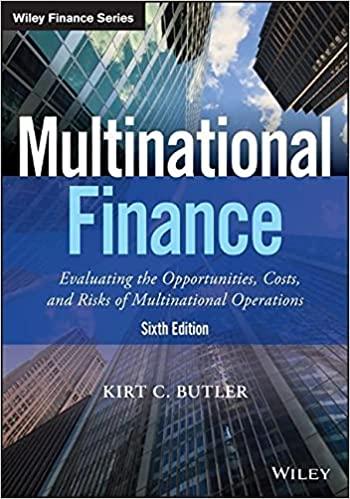Question
Bartman Industries and Reynolds Incorporateds stock prices and dividends, along with the Wilshire 5000 Index, are shown below for the period 1996-2001. The Wilshire 5000
Bartman Industries and Reynolds Incorporateds stock prices and dividends, along with the Wilshire 5000 Index, are shown below for the period 1996-2001. The Wilshire 5000 data are adjusted to include dividends.
| Year Bartman Industries Reynolds Incorporated Wilshire 5000 Stock Price Dividend Stock Price Dividend Includes Divs. |
| 2001 $ 17.250 1.15 $ 48.750 3.00 52.300 2.90 48.750 2.75 57.250 2.50 60.000 2.25 55.750 2.00 11,663.98 8,785.70 8,679.98 6,434.03 5,602.28 4,705.97 2000 1999 1998 1997 1996 14.750 1.06 16.500 1.00 10.750 0.95 11.375 0.90 7.625 0.85 |
-
Use the data given to calculate annual returns for Bartman, Reynolds, and the Wilshire 5000 Index, and then calculate average returns over the 5-year period. (Hint: Remember, returns are calculated by subtracting the beginning price from the ending price to get the capital gain or loss, adding the dividend to the capital gain or loss and dividing the result by the beginning price. Assume that dividends are already included in the index. Also, you cannot calculate the rate of return for 1996 because you do not have 1995 data).
-
Calculate the standard deviations of the returns for Bartman, Reynolds, and the Wilshire 5000. (Hint: Use the sample standard deviation formula given in the chapter, which corresponds to the STDEV function in Excel.)
-
Now calculate the coefficients of variation for Bartman, Reynolds, and the Wilshire 5000.
-
Construct a scatter diagram graph that shows Bartmans, Reynolds returns on the vertical
axis and the market indexs returns on the horizontal axis.
-
Estimate Bartmans and Reynolds betas by running regressions of their returns against the
Wilshire 5000s returns. Are these betas consistent with your graph?
-
The risk-free rate on long-term Treasury bonds is 6.04 percent. Assume that the market risk premium is 5 percent. What is the expected return on the market? Now use the SML
equation to calculate the two companies required returns.
-
If you formed a portfolio that consisted of 50 percent of Bartman stock and 50 percent of
Reynolds stock, what would be its beta and its required return?
-
Suppose an investor wants to include Bartman Industries stock in his on her portfolio.
Stocks A, B and C are currently in the portfolio and their betas are 0.769, 0.985 and 1.423, respectively. Calculate the new portfolios required return if it consists of 25 percent of Bartman, 15 percent of Stock A, 40 percent of Stock B and 20 percent of Stock C.
Step by Step Solution
There are 3 Steps involved in it
Step: 1

Get Instant Access to Expert-Tailored Solutions
See step-by-step solutions with expert insights and AI powered tools for academic success
Step: 2

Step: 3

Ace Your Homework with AI
Get the answers you need in no time with our AI-driven, step-by-step assistance
Get Started


